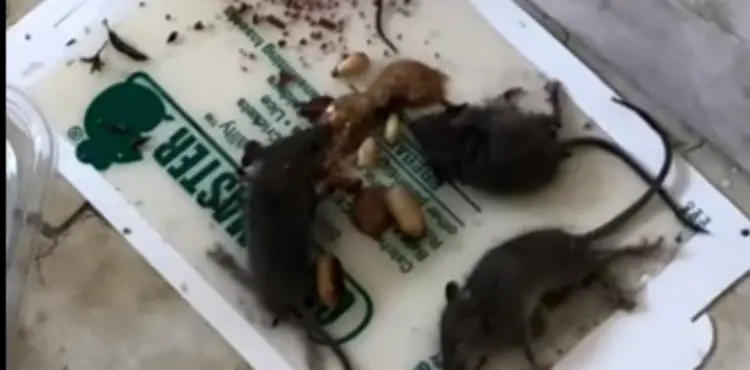Can a mouse move a glue trap? It depends on the size of the mouse and how the trap has been placed for a mouse to move the trap. If the mouse is large enough, it can quickly move the trap. Meanwhile, a tiny mouse will struggle a lot to move the trap.
Single-placed traps also make it easy for mice to move. Whereas traps placed in pairs are tricky to move.
This article will tell you everything about mice, glue traps, and how they can move them. So, let us not beat around the bush anymore and get to the topic straight.
Keep reading!
Can A Mouse Move A Glue Trap?
Not all mice can move a glue trap. Some succeed, and some do not. You must be thinking that a mouse can easily drag the trap to a wall and pull itself out or gnaw off its paw. But that is not the case every time.
For instance, a tiny mouse or a mouse that is completely stuck in the trap can’t move it. Other factors depend on whether or not a mouse can move a glue trap.
The below traits will make you affiliate with the concept. Now, let us have a look at the information below.
Mice May Not Move Traps;
Suppose a mouse got stuck in the trap in the middle of the body. At that time, it couldn’t move its limbs. So, it would be impossible for the mouse to move the trap.
Stucked Tail Can Avail To Move The Trap;
As said before, when a mouse’s middle part of the body gets stuck in the trap, it becomes impossible for the mouse to move the trap.
If the tail of the mouse gets stuck in the trap, the mouse can quickly move the trap because its limbs and body parts are free.
Paired Traps Are Hard To Move;
If the house owner has placed more than one trap together, the mouse that is trapped may not be able to move the trap. Because it will be hard for the mouse to pull itself. But if the trap is placed singly, that can be somehow possible for the mouse to move the trap
The Size Of The Mouse Depends;
Small mice can find it hard to move the trap because they don’t have that much strength. Also, they can’t give a long jump over the traps like larger rodents.
Thus, a tiny mouse can hardly move or escape a glue trap. Whereas a large mouse can find it easy to move a glue trap, its strength is also ample and can give long jumps over the traps.
Glue Traps Lead To Painful Death;
Most of the time, mice die after trying very hard to move the glue trap. Glue traps make mice stuck so hard that it becomes impossible for them to escape the traps.
When a mouse moves a glue trap, it can tear its skin, break its neck, chew its legs, and so on. As a result, the mouse gets to a painful death.
It Is Very Hard To Move Glue Traps;
We already know that mice go through severe struggles while moving a glue trap, like- chewing their limbs, tearing their skin, etc. If the mouse is strong enough, it can survive after getting through these pains.
If it is ready for the pain, it will move the glue trap. But it would be surprising if the mouse stays alive even after these injuries. So, it is uncertain whether the mouse will move a glue trap.
Frequently Asked Questions
How To Dispose of A Live Mouse In A Glue Trap?
The glue in the trap will not stick to the mouse for long. The mouse will be released from the trap after some time.
When the mouse gets free from the trap, dispose of it in a plastic bag and throw it in the garbage. And don’t forget to free the mouse and get it away from your home.
How Long Does It Take A Mouse To Die on A Glue Trap?
After getting trapped in a glue trap, a mouse struggles a lot to get out of it. For this reason, it will suffer exhaustion, and its face will collapse into the ground.
It will also go through suffocation, starvation, and exhaustion, which can lead to death within 24 hours. Sometimes, it takes more than one day for a mouse to die in a glue trap.
How To Remove A Mouse From A Glue Trap?
First, you have to take the trap in a container and put oil at its base. Try to use extra virgin oil. Afterward, cover the container. The mouse will get released from the trap by itself. Then, you can dispose of the mouse.
Are Mice Attracted To Glue Traps?
Mice are attracted to glue traps when their favorite foods are attached to them. Peanut butter, chocolate, vanilla extract, etc., attached in the middle of traps attract mice more. And yes, gloves should be used while setting the traps, as mice can avoid them by sensing the human smell.
Final Thoughts
Hopefully, the abstract will give you an oriented distinction as to whether a mouse can move a glue trap or not. However, most of us still have the question in our heads- Can a mouse move a glue trap? Well, the answer is yes.
Moving only one glue trap is possible for a mouse if it struggles a lot to do so. We have already said that single-placed traps are more accessible for mice to move. Besides, a giant mouse can not only move the trap but also escape it.
So this is all. Let us know through the comment section below if you have any queries.
Thank you.

